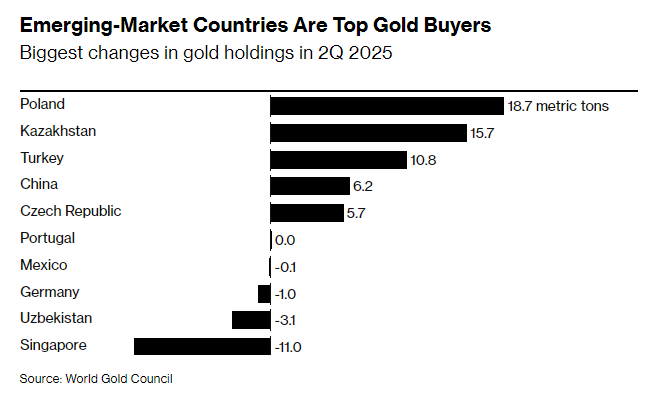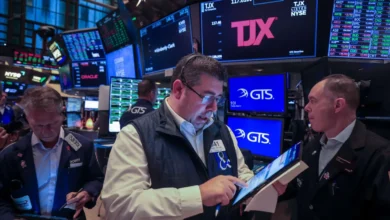Gold Production and Accumulation! Emerging Markets Catch the Gold Bull Market.

The sustained surge in gold prices is delivering unexpected gains to emerging markets and bolstering investor confidence in both gold-producing and gold-purchasing countries.
According to Zhitong Finance APP, the sustained surge in gold prices is bringing unexpected gains to emerging markets and boosting investor confidence in gold-producing and gold-buying countries.
As the country with the deepest gold reserves globally, South Africa’s stock market is on track for its best annual performance in two decades. Shares of mining companies such as Sibanye Stillwater (SBSW.US), AngloGold Ashanti (AU.US), and Gold Fields (GFI.US) have tripled. The credit rating of Ghana, Africa’s largest gold producer, has also been upgraded by Moody’s. Emerging market countries, ranking among the largest buyers of gold, are gaining solid fiscal support from this trend.
For fund managers in emerging markets, the remarkable 60% bull run in gold prices this year provides even more reason to remain optimistic. Rising gold prices generate wealth effects for both producing and purchasing nations, and holding substantial gold assets increases investors’ confidence in buying. In a report released earlier this month, Goldman Sachs strategists highlighted South Africa’s advantage in the mining sector as one of the key reasons for their positive outlook on the country’s bonds and stocks.
Daniel Wood, portfolio manager at William Blair Investment Management, stated: “The rise in gold prices benefits a few emerging market countries, including Uzbekistan, Ghana, and South Africa. The broader context of rising gold prices is that investors are increasingly seeking alternative investments to reduce reliance on traditional developed-market currencies—particularly the US dollar.”

Wood noted that he is bullish on the Uzbekistani currency because the country is both a major gold producer and holds significant gold reserves. He added that the surge in metal prices is one of the reasons behind South Africa’s historic market performance this year.
The FTSE/JSE Africa All Share Index in South Africa has risen by over 30% this year. The South African rand is trading near its highest level in a year, while the yield on 10-year government bonds recently fell below 9% for the first time in seven years. Slowing inflation has allowed the central bank to cut interest rates, further boosting market sentiment.
Overall, for a country that has struggled to attract investors due to political instability and power shortages weighing on economic growth for many years, the current situation represents a dramatic turnaround.

Ghana is another country that has benefited from the rise in gold prices. In 2022, Ghana faced an economic crisis and defaulted on its debt, but under the leadership of new President John Mahama, the country is on a path to recovery. This year, the Ghanaian cedi has appreciated by about 38%, the highest increase globally.
Other investors have indicated that they are closely monitoring countries such as Poland, Turkey, and Kazakhstan, which continue to increase their gold reserves. However, Alexis de Mones, a fixed-income portfolio manager at Ashmore Group Plc, noted that while this trend is generally positive, investors should not overinterpret it.
He stated, “Countries with higher proportions of gold reserves do appear to be in better shape, but the impact of price movements should not be regarded as a source of credit strength.”
De Mones added that a more significant driver for emerging markets lies in the fact that rising gold prices coincide with a weakening dollar and an overall easing of financial conditions. This view is shared by Ning Sun, Senior Emerging Markets Strategist at State Street Bank in Boston.
She stated that rising gold prices are usually part of a broader trend that weighs on all risk assets. However, this time is different, as concerns about a weak dollar and U.S. economic policy have reversed this relationship. Now, emerging markets have instead become the winners.
“This rise in gold prices is more beneficial to emerging markets than to developed markets,” she said. “Emerging markets not only produce gold but also hold substantial gold reserves.”
Wall Street financial giant Goldman Sachs has significantly raised its forecast for the spot gold price in December 2026 from $4,300 per ounce to $4,900. Another Wall Street heavyweight, Bank of America, has provided an even more aggressive forecast. A separate sensitivity analysis from Goldman Sachs showed that if only about 1% of U.S. Treasury bonds held by the private sector were to flow into gold assets, the spot gold price could approach $5,000 per ounce.
Strategists at Bank of America stated that gold prices could reach $6,000 by next spring. Statistics from Bank of America indicate that the allocation of gold assets in global institutional portfolios and private client asset allocations remains relatively low, standing at only 2.3% and 0.5%, respectively. This suggests that structural long positions in gold are not crowded in the market.






